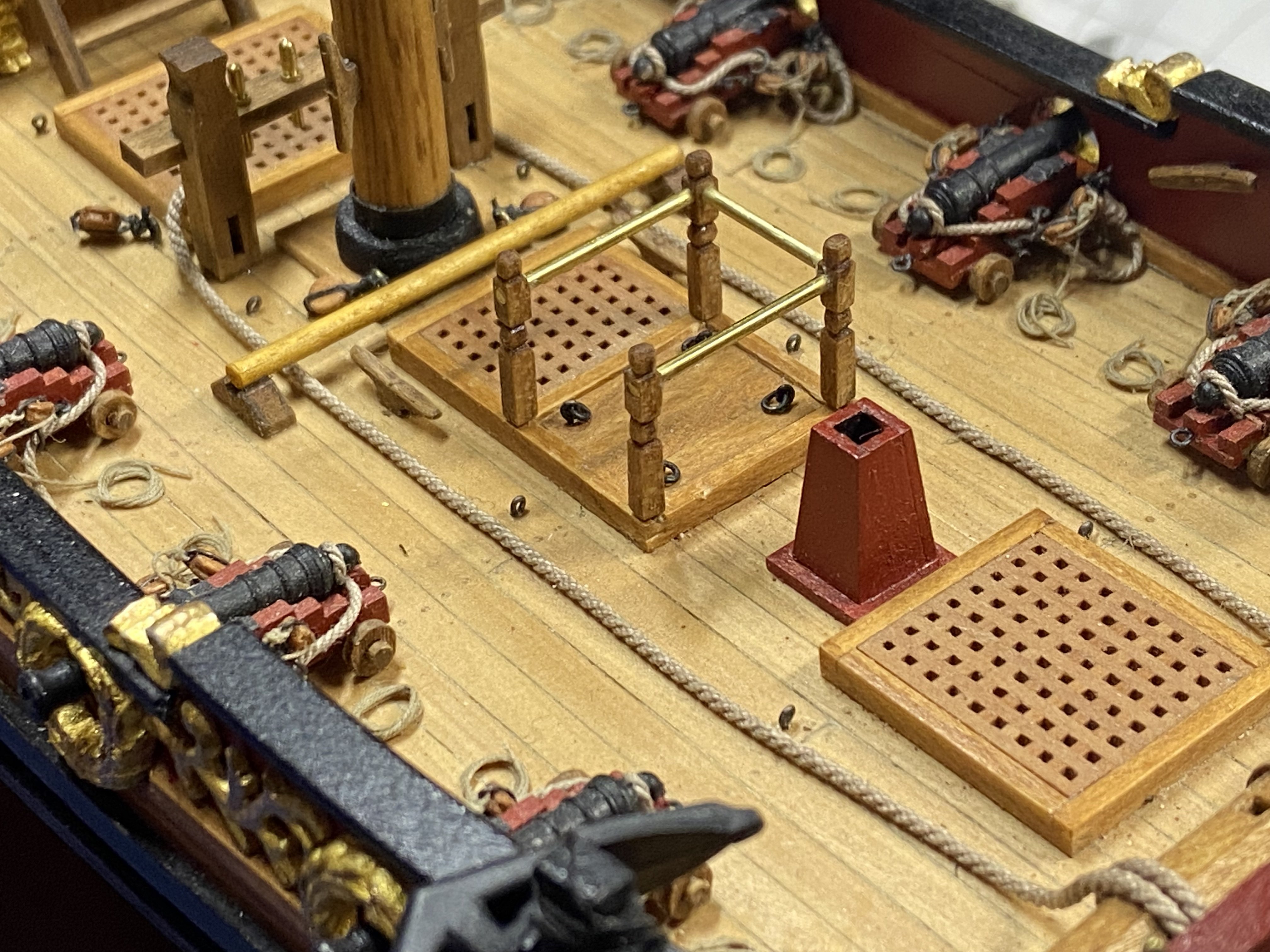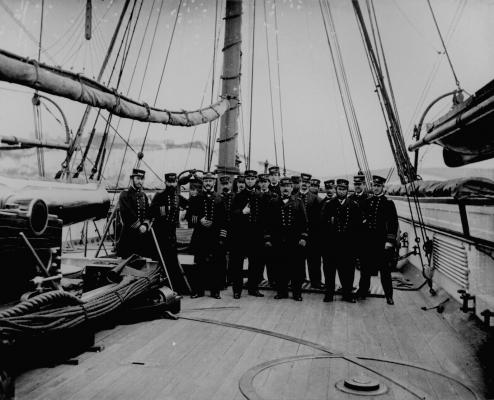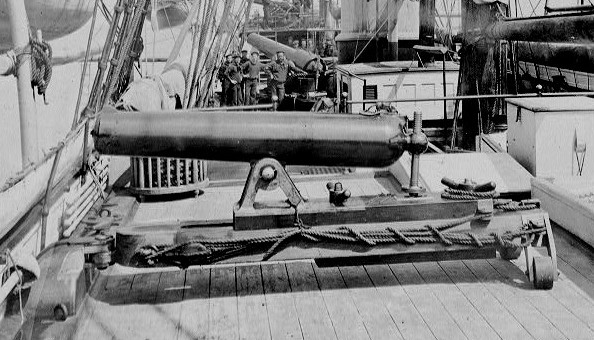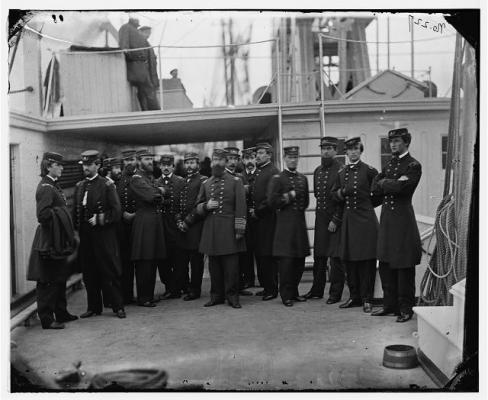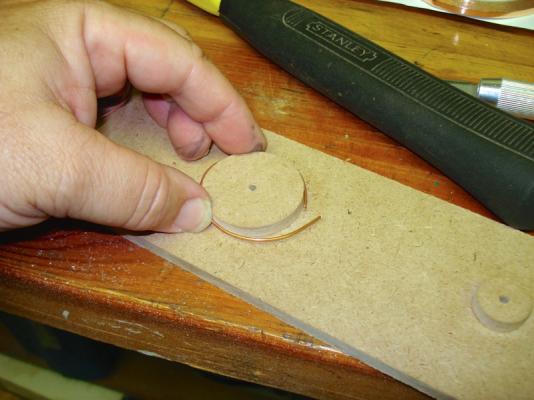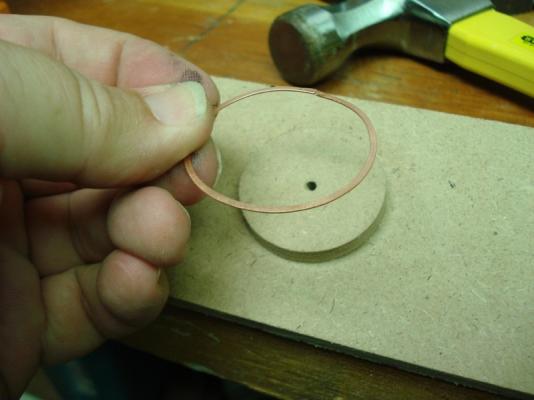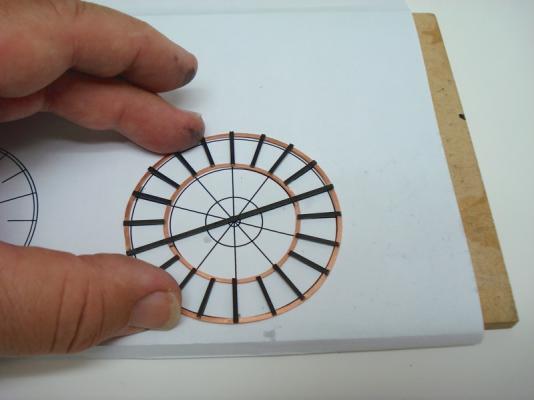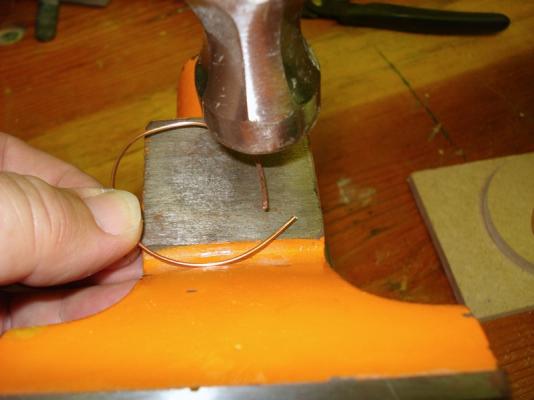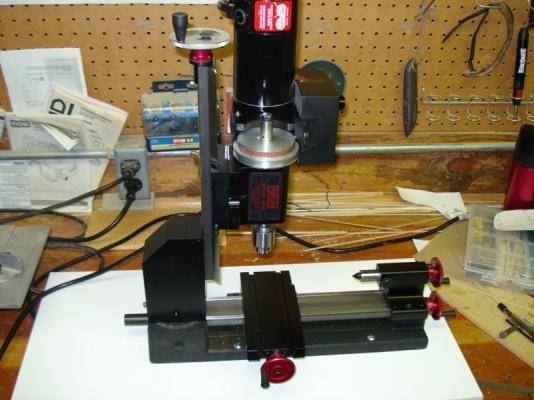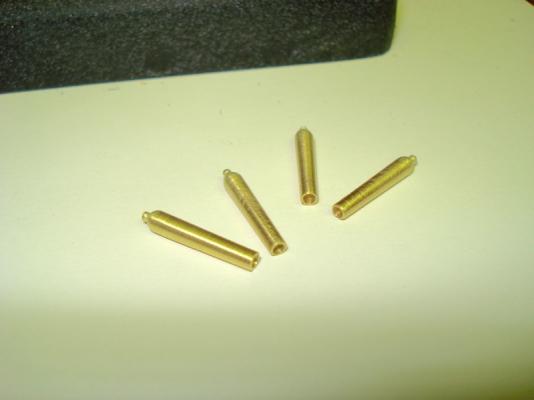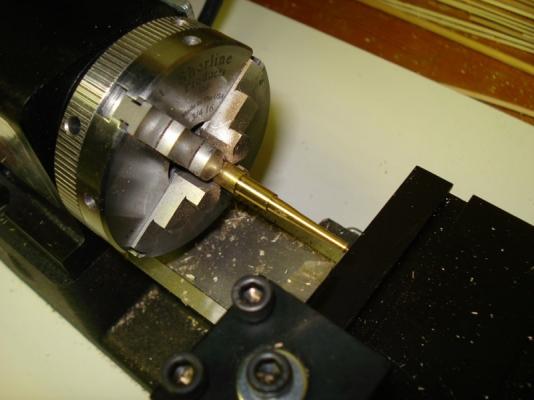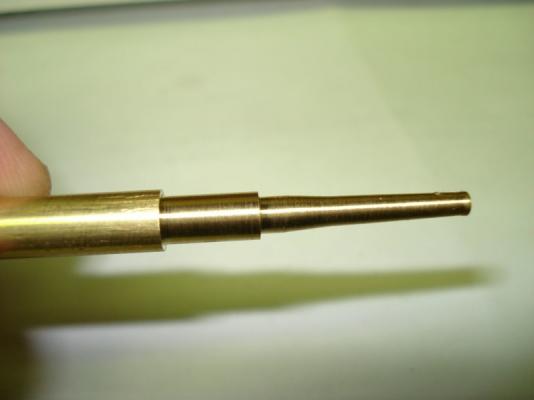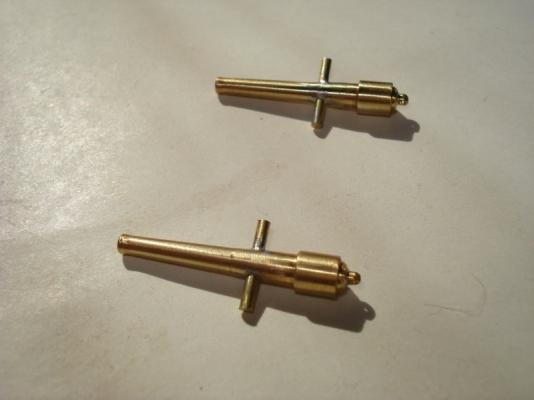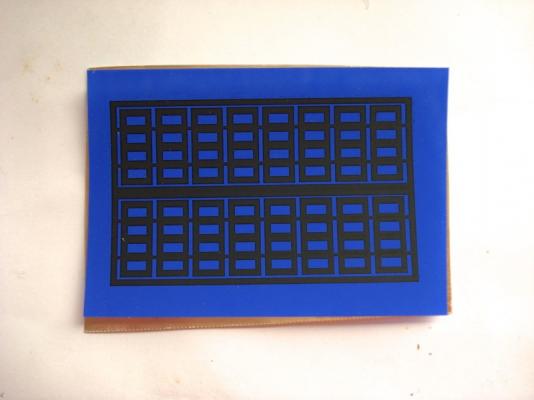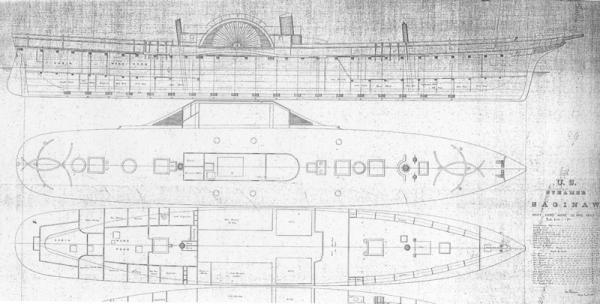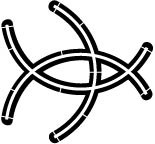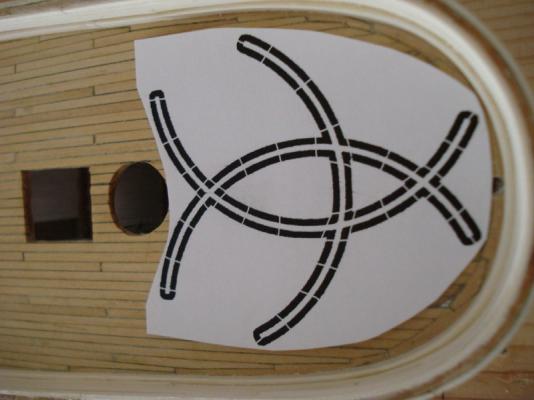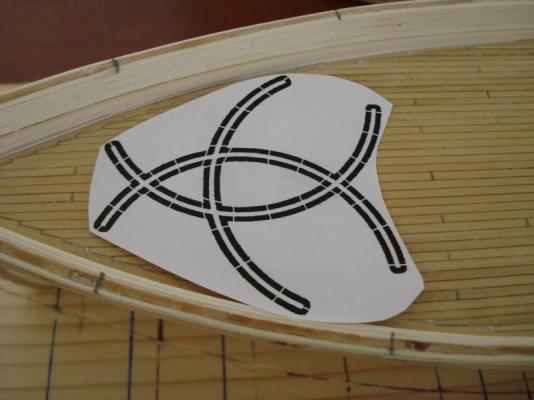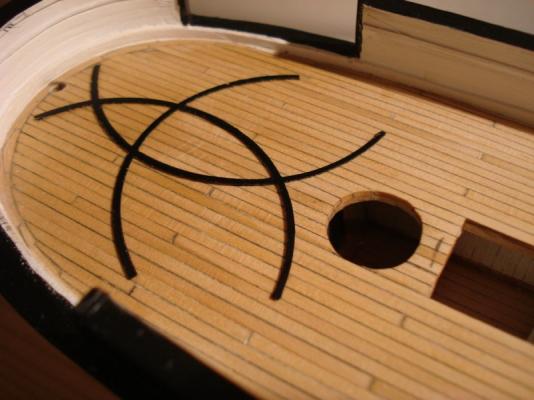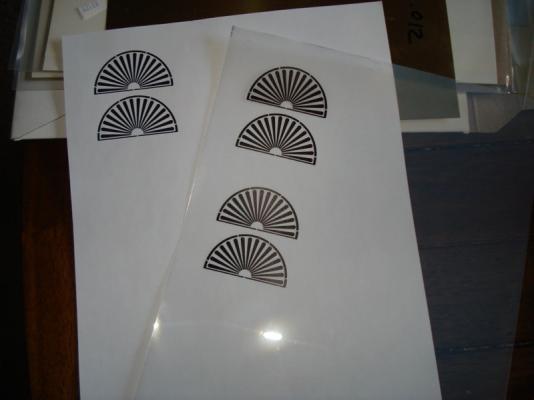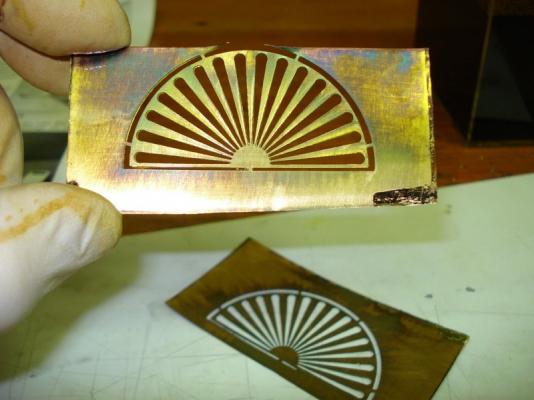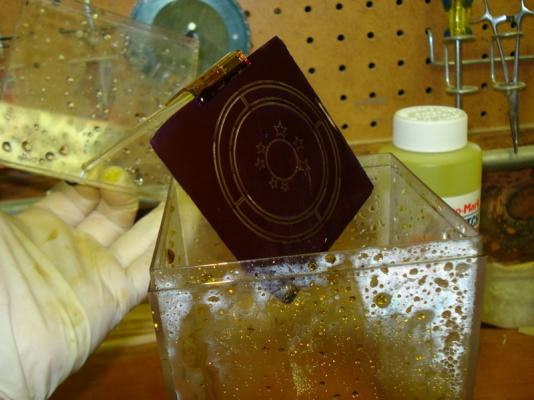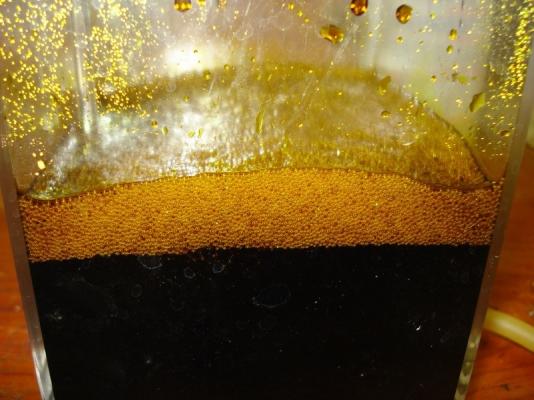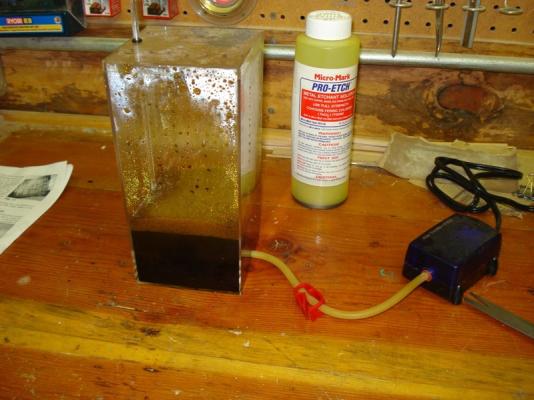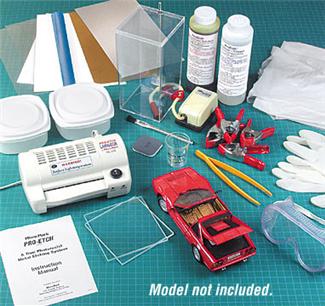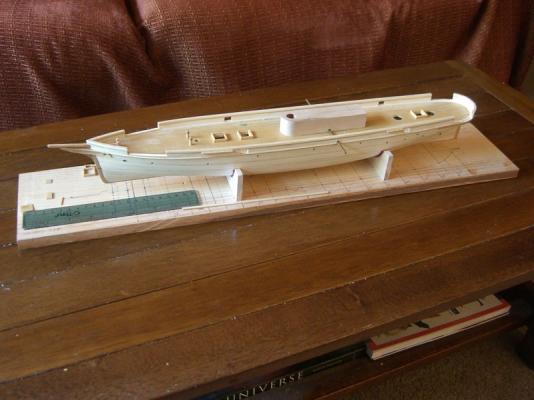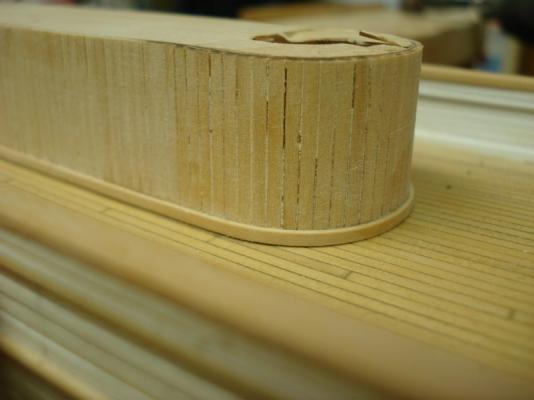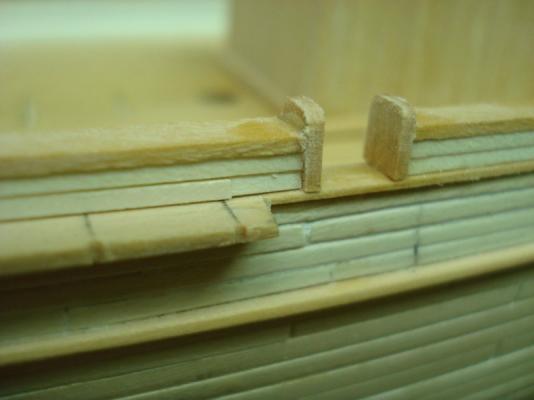-
Posts
1,853 -
Joined
-
Last visited
Content Type
Profiles
Forums
Gallery
Events
Everything posted by catopower
-
Yikes! Are you just giving me a hard time about my ongoing photo etching issues? Shall I just pass the salt so you can rub some of that into the wound too?
-
By the way, does anyone know what these poles are that sometime appear on the bulwarks of Civil War era ships? The following is a photo of the Kearsarge. There are some that look very similar behind the Dahlgren boat gun on the USS Nipsic. Finally, there is something similar, but not painted white in a rack behind these officers aboard the USS Malvern. Any thoughts? At first, I thought they might be hand spikes for handling the cannons, but they seem too small for that, particularly for the large pivot gun in the first photo, and there are a lot of them together in one place. Boarding pikes? Seem short for that too, though that might just be a perspective issue. Clare
-
Thanks for the support guys! Sorry progress has been so slow. Perhaps with this "breakthrough" on the paddle wheels, I can get some forward momentum going again. I did finish all four sets of rims. Next, I'll be working on the hubs of the wheels and the connecting spokes. Finally, come the cross bracing and paddles themselves. We'll see how all that goes. I'm thinking now about how I want to make the hubs. I was initially thinking of making one-piece hubs turned from brass. But, now I'm realizing that adding the spokes will be easier if I can make separate hubs for each rim, add the spokes and then put the halves together. I'll let you know what I come up with... Clare
-
Paddle Wheels I decided to set aside the armament constructions while I get back to an assembly that's been holding everything up on this model as I was trying to use brass etching and improving that technique. So, I finally decided that enough was enough and it was time to just build the paddle wheels. I went back to an old fashioned method of metal working to make flat rings for the paddle wheels. I had use large gauge (relatively speaking) copper wire wound into a circle and then flattened with hammer and anvil making the wire into a flat ring. I used this method to make circular tracks for pivot guns on a few models in the past. It worked then and maybe my touch has improved a little. At least I can hope. For the Saginaw's paddle wheels, I would need 2-1/2" diameter outer rings. The diameter of an inner set of rings depends on which drawings you look at. I chose to use the original sheer plan drawings of the Saginaw, which show a basic paddle wheel structure. There is another set of detailed drawings available, but it's not clear if these drawings are actually specific to the Saginaw since the name doesn't appear anywhere on them. In any case, the inner ring diameter I'm using is approximately 1-9/16" diameter. I made up some template on my computer and used them to create a set of MDF formers for the ring sizes needed. The templates were glued to the MDF board and cut to shape. The formers were then glued to an MDF board base. 18 gauge copper wire was bent around formers to create rings of appropriate size. The copper wire rings were then carefully set on an anvil and tapped carefully with a hammer, flattening out the wire little by little. The wire tends to straighten itself in the process and is regularly bent on the former back to shape. The wire also tends to twist, so the piece is turned over regularly to undo any twist. As the wire is tapped flat, the ring flattens and widens. At this scale, the ring should actually be only about 1/32" wide (just under 4" at full size), but that makes it too flimsy for me to work with, so my aim has been about 3/64" to 1/16". Once the rings were made, I had intended to silver solder them closed, but found it was easier for now just to CA the ends together. The effort here is to get these done so I can get work on the hull and deck structures going again. I made another template for lining up the rings and the spokes, again printed off the computer. For the spokes, I used 1/32” thick by 3/64” wide boxwood I had on hand. For the time being, I just deal with the part of the spokes connecting the two rings. The longer spoke sections that reach out from the hub, do so at an angle, so I simply left room along the inner ring for these to seat. The very first spoke was run across the whole assembly to hold the rings into place while all the short spokes were glued into place. Clare
-

Thickness sanders.....Byrnes vs Micro Mart
catopower replied to bigcreekdad's topic in Modeling tools and Workshop Equipment
I have the MicroLux thickness sander (it's MicroMark, by the way) and I'm perfectly happy with it. I've use it and I've used the Byrnes and both work about the same. As someone pointed out, you can't pre-set the thickness on the MicroLux, but I don't recall being able to do that with the Byrnes. For both the MicroLux and the Byrnes Machines sanders, I've had to take off a little bit of wood at a time and then measure the resulting piece. The comment that the MicroLux sander only sands basswood is hogwash. I've never once thickess sanded basswood with it. As I've been milling most of my own wood these days, I use it regularly on Boxwood, Cherry, Pear, Holly and Beech. It works fine, is very heavy and feels very rugged, very sturdy. The main difference between the two, in my experience, is in design. The MicroLux sander works. It's not super user friendly. The Byrnes Machines sander works. It's well designed, so it's more user friendly. For instance, the Byrnes sander uses a screw to adjust the thickness and it has a large diameter thumb wheel. The Microlux model uses a hex bolt. It works, but it's not as nice and its location is a bit awkward. Plus, as I recall, on the Byrnes sander that adjustment screw is easy to reach and the fine threads on it give you more precise adjustment. The vacuum hose attachment on the Byrnes sander is on top so it's out of the way. The Microlux sander put's it on the side where the wood comes out, so you have to do more to get it out of the way of your work. The Byrnes sander uses standard sandpaper making it inexpensive to operate. The Microlux uses special sanding sleeves which cost a lot more, though they seem to last a long time. I haven't changed mine since I bought it, which is a good thing as the Microlux drum sander requires you to practically disassemble the whole machine to change it. The Byrnes sander is much simpler here - again a better design. Plus, on the Byrnes, you can use grits of your choice. On the Microlux, your choices are limited to the 3 available grits. One thing I should add is that the Microlux thickness sander has a big heavy roller on the feed side that is designed to hold down your work as you feed it in. I found this was more of a hassle than an asset, so I removed mine. Every time a piece was almost through the sander, the think would drop with a thunk and jar the unit and the work piece so that the last bit of the work piece would come out uneven. I was much happier with the machine after I took this piece off. Overall, the Microlux is less expensive but it's clearly not as well designed as the Byrnes product. It's still VERY useable and I have no sense that I've missed out by buying it. It's clearly not perfect, but it does its job and I use it about once a week or so. But, the Byrnes thickness sander is really not that much more money than the Microlux model unless you can get it at a good sale price from Micromark. So, you may want to pay a little more and spring for the Byrnes model. Clare -
Thanks Dan and Mark for the suggestions. Dan, I may give that a try. Not sure how to keep the drill bit centered on something as small as .050" and keep it from wobbling. I'm a little concerned about destroying the cascabel, so I'll try on some similarly sized wire first. If I can get that to work well enough I'll try it out on the cannons. Thanks for the encouragement! Clare
-
Wow, thanks all for the nice comments. I appreciate the support. You've all inspired me to finish up by turning the Dahlgrens... So, here's the last of my machining for the moment. I turned the four 24-pounder Dahlgren boat guns yesterday. This turned out to be much more of a task than I'd expected. I did one test a week ago and it seemed easier. I think the trickiest part was probably that I had to try to make all four identical – or as close as I could come. Note that the cascabel on the end of the breech end is supposed to have a hole in it, but it was way too small for me to work with. I know for the future I'm supposed to drill the holes before I do the turning. But, at this scale and with the small size of the cannons, I think the tolerances necessary are too tight for my current skills. So, I elected not to drill them. I'll fake the elevating screws somehow. Also, I haven't soldered on the mounting lugs yet. That's next after I clean up the barrels a little. By the way, here is a picture of my Sherline lathe modified with the addition of a milling column. Makes this thing extremely versatile, though I think the Unimat is more designed for versatility. Still, I only have to turn one hex screw to remove the head stock, place the milling column and tighten a similar screw, attach the head stock in its new location and tighten the screw again and it's all set. Also, thanks for the tip Mark. I've certainly got a lot to learn on using machine tools. Clare
-
Turning the Parrot Guns The Saginaw gave me my first opportunity to really put my new Sherline lathe to work and to put me to the test. This is the first lathe I’ve ever used, though I did learn to use a vertical mill many long years ago in a physics department machine shop. I first took a drawing that was published in a Ships in Scale article of a 30 pounder Parrot rifle (originally from the National Archives) – the exact gun I needed for the Saginaw – and scanned it into Adobe Illustrator. I have a very old version of the software on an old Mac. It won’t run on my newer system, so I signed up for the trial version of Adobe’s Creative Cloud version. At 30 days, it was plenty of time for my purposes. I scaled the image down so that it matched the model size and then used Illustrator’s measuring tool to get exact measurements for the guns. I can’t really tell you much about the process of making cannon barrels on the lathe except to say that I haven’t done so much math in a long time. Basic stuff, simple addition, subtraction, occasional division, but lots of it. As I mentioned in a previous post, I’d figured on making one successful cannon and then using that for casting. But, I ended up turning both the Parrot guns instead. For this reason, I wrote out a step-by-step description of each cut and each related measurement so that I could repeat it easily. I made three barrels so I could take the best of the three, though the very first couple I did, I rejected pretty quickly and had to start up a couple more. To keep them as uniform as possible, I decided to do a couple steps at a time on one barrel and then switch barrels and repeat those steps, keeping all three barrels taking shape at the same time. This seemed to help keep me from making silly mistakes and kept the barrels fairly uniform. I know I should have cut the holes for the trunnions first, but I managed to add them later, though at great difficulty. I was just more concerned about getting the three barrels to look right, figuring I could deal with drilling them later. To make a long story short, I managed to finish them and I’m happy with how they turned out. They aren't perfect, but I'm happy and when blackened, many of the flaws will be pretty well hidden from view. In the end, I learned a lot and really enjoyed the machine shop work. As for the lathe itself, I originally wanted to get a vertical mill, but since I had more immediate need I went with the lathe. My funds are pretty tight, so I decided to simply accessorize and build up a mill over time. I know it’s more money in the long run, but it’s really easier to take smaller steps. I’ve since purchased a milling column that will fit in place of the lathe’s headstock and then the headstock mounts on the column. So, for $170, I have a basic mill. I’ve already tried it for some basic work and already I love it. Operation is so precise and so smooth. Next on the Sherline, I’ll be turning the Dahlgren boat guns. They're simpler in shape so they should be easier to do. More on that later... Clare
-
Thanks Brian, but it sure feels like it's moving along slowly... By the way, I've always wanted to mention that I like your big brain Talos IV guy photo. Grant, I was really happy when I bought it, though for a while I really didn't know what to do with it. Plus, I had to figure out what accessories I needed, just to use the thing – I bought the very basic lathe with no accessories. Clare
-
Thanks for your comments Grant. I plan on writing about being successful with the brass etching very soon! Just as soon as I succeed... Mark, thanks for the suggestion. I was figuring I'd eventually post there, but maybe I'll do it sooner rather than later. I'm going to give another shot to making the rings for the paddlewheels from etched brass. I just got my order in from Micromark on Friday, so I'll get back to that soon. In the meantime, I got a bit distracted by starting work on the guns. The Saginaw carried two 30-pdr parrot rifles in 1870, along with four 24-pdr dahlgren boat guns. I bought myself a Sherline lathe a couple months ago and this will be the first attempt to make something significant with it. I've got very little lathe experience, so it's a slow learning process. I'll write a post about it, but I'll say now that I've been really enjoying the metal work. It was a bit intimidating at first, but I'm just now starting to get comfortable with it. Initially, I figured I'd be lucky to make one of each type of gun and planned on using them as masters for casting. But, after I found that the initial silicone molds I made weren't very good, I decide with so few guns, I'd just turn them all. Anyway, I need the practice on the lathe. More on that shortly. Clare
-
Today, I just received my copy of Ancre's monograph of the cutter Le Cerf, 1779-1780. It's a great product, but I really want to point out here is that if you live in the U.S., I strongly advise you to pay the extra money to order by a trackable express shipping service. I first place an order for this product on March of this year. Figuring it might take 4 or 5 weeks to get, I waited a couple months and nothing showed up, so I emailed them. I didn't hear anything back, so I posted on the Seaways mail list asking what other people's experiences were with ordering from Ancre. Next thing I know, I got an email from Ancre asking how they could help. He immediately shipped the product to me and all was looking well. Then, 4 weeks went by and 6 weeks. As the 8th week was approaching, I wrote again. Mr. Didier Berti (Hubert Berti, his father, had passed away in the Spring) offered to reship it by express service if I wanted to pay the cost and I was very happy to spend the extra money this time. So, today, the book shows up at my home in California, a mere 4 days after it was shipped from France. I have the product, an excellent product by the way, and all is well. Maybe shipping to other parts of the U.S. will have better luck, but for shipping to the west coast I STRONGLY advise you to pay the extra chunk of cash to order via trackable, express shipping. Anyway, you're going to want your Ancre orders quickly so you can enjoy the amazing quality of their products right away. Ancre - Collection Archéologique Navale At last, another happy Ancre book owner. Clare
-
Hi John, I just wish I could give you a detailed account of my SUCCESSFUL etching experience. Might be MORE helpful Clare
-
Thank you everyone for your great support. It's much appreciated and is helping to keep me on task. So, about a week ago I restarted the process to do some etching of some rings for the paddle wheel. I'd looked at various ways to make them, but at 1/8" scale, etching brass seemed to be the best option IF I could get it to work. I had made rings for one side of one wheel many months ago and recently looked at them again and they actually look okay. Anyway, I realized that about 60% of the work will be hidden by the wheel houses, and for that matter, you can only see about 1/2 of one wheel at a time, so I've come to realize that if they're not perfect, it probably won't be at all noticeable. Got the gumption up to get started and realized I didn't have enough photoresist material, so I went ahead and reordered that and some new etchant. I've been kind of winging it on keeping track of how much I've used, so I'm going to get very methodical about recording dates and uses from now on. The stuff is still a few days away via FedEx Ground, but I should have it by Friday. So, while I'm posting, I should mention that one of the problems I've been having with etching is trying to get a little more streamlined and greener. The chemicals, primarily the etchant, has to be disposed of properly and for me that means taking it to the hazardous waste facility. I haven't had to go there yet, but it should be a pretty straight forward visit and it's free. So, no complaints there about the service. Another Method of Etching Still, I wanted to make life simpler. So, I tried out another form of metal etching. There are basically two kinds of metal etching: Chemical etching and Electrolytic etching. Chemical etching is what I've been doing up 'til now. Electrolytic etching is the exact opposite as electrolytic metal plating. Or, in actuality, it's exactly the same as electrolytic plating, but instead of taking a source metal and plating your work, your effectively using your work as the source metal and plating a piece of waste metal. Seems like a good idea, but I didn't have the patience to try to work out all the kinks. You have to prep the metal pretty much the same way as with chemical etching. But, instead of putting it into an etchant bath of Ferric Chloride, you put it into a bath of Copper Sulfate solution, which is much safer to work with. You need a power source, like a car battery charger and piece of copper to deposit the "etched" metal onto. The problems I ran into were that the copper sulfate solution (Ferric Chloride seems thicker to me) seemed to work its way underneath the photoresist a little, so the etching didn't look very clean. Also, I think the process works best if you use a sheet of copper for the process to deposit to and to keep it as parallel to the work as possible as closer areas etch faster than farther ones. Lastly, the power source has to be attached to the metal plate in such a way that the wiring or the part of the copper it's attached to doesn't get eaten away. I'll have to revisit this in the future. And, since it is the same process as plating, I may have to give that a try too! Press 'n' Peel Blue Sometime after I gave up on that, I looked into another possibility to improve/simplify the process. It seems to me that the most difficult part of the etching process is basically getting the artwork onto the metal. The metal has to be really clean and the photoresist material has to be applied with no dirt or air trapped underneath. But, working with photoresist can be a bit of a pain as you also have to get the right exposure to transfer the image onto it and you have to process it in the developer solution just right so that all of the unexposed photoresist washed away and the exposed material is completely intact. Lately, I haven't been doing so well with this. Then I ran across an article on a modeling website about using a material called Press 'n' Peel Blue. Press 'n' Peel Blue is a material that you print directly onto and apply heat to transfer directly to metal. The idea seemed like a godsend. I mean, no UV exposure to worry about, no transferring an image of an image, no need for using nasty developer solution (NaCl). Seemed too good to be true. Well, for me, it was too good to be true. I had to invest in a laser printer to begin with because this method is specifically for transferring laser toner onto metal and it won't work with an inkjet printer. Laser printers can be had pretty cheaply, but toners cost a chunk of money. Since I wasn't planning heavy use, it seemed a reasonable investment. The one caveat is that, reportedly, Brother printer toners require too much heat to transfer so they aren't recommended. I didn't see any warnings about Canon printers, so that's what I ended up with. To make a long and painful story short and less painful, I just couldn't get the toner to stick to the metal well enough. From what I've read about this stuff though, it's used for prototyping circuit boards and it's not uncommon for part of the artwork to not stick. You just use a sharpie marker to draw in any missing lines by hand. When your only worried about making a circuit connection, that's probably okay. But, when you need something to look perfect, that's not a good solution. Just in case, I also tried using one of the copiers at FedEx Office to copy my artwork onto the Press 'n' Peel Blue sheet. But the results weren't any better when I tried transferring to the metal. I tried cleaning the metal with acetone before and after rubbing it down with very fine grit pads, I tried cleaning the metal with steel wool, scouring pads, nothing helped. The stuff just wouldn't transfer cleanly. At some point, maybe I'll try to find an HP laser printer as that is probably the most common brand and may work the best. But, that doesn't mean that this stuff is entirely useable for ship modeling. Other Etchants Finally, I started to experiment with other etchants. One seemed to be the best possibility and I was really trying it in conjunction with the Press 'n' Peel Blue testing. I didn't get very far with the test, but I decided to try out Sodium Persulfate. This stuff starts off clear and I'm told that you won't have the problems of undercuts in the etching (etching too much so that it cuts underneath your artwork). Because it's clear, you can see the process without removing and rinsing the work all the time. Also, I believe it's environmentally a bit better as you end up with (I think) mostly Copper Sulfate, though I haven't figured out what happens chemically to the sodium. Anyway, I only tried this once and it was with the Press 'n' Peel Blue and I could tell that using a Sharpie marker on the artwork wasn't working out too well, so I stopped the process midstream. I'll have to try it again in the future, but it is a much slower process than using FeCl. Back to the Start For now, I'm going back to the start and see if I can deal with the process and the chemicals and at least get some decent etching done! I'll let you know how it goes... Clare
-
Pivot Gun Tracks Back to catching up on the build log... On the pivot gun tracks, I began by using Adobe Illustrator to create the artwork. The tracks for the pivot guns are based on the National Archives plans. The two are identical and simply consist of three overlapping arcs. As I mentioned in the previous post, the trick in creating the artwork is to create the areas to be etched away. So, the black areas in the artwork will etch away, leaving the white areas as the brass parts. You don’t want to create unnecessary black areas as you end up wasting etchant on areas that don’t actually need to be etched. So, the bulk of the artwork is white. The fine white lines are small brass bridges that will keep the etched part from falling off the sheet during the etching process. I included too many of these in my early work and realized it just made for more clean-up. So, my later artwork has only as many as seemed necessary and reasonable. Once I had completed the art, I printed it out on regular paper and test fit it on deck. This was just an extra step to make sure I didn’t miss anything. I was getting uneven thickness in the widths of the track and It took me a few attempts at etching to get the tracks to come out well. I started to realize at some point that some of the unevenness I was getting in the etching came from the exposure process, where some portions of the art were being struck at an angle by the light I was using. So, some areas were receiving stronger exposure than others. I adjusted this by turning the artwork at regular intervals during the exposure process and that helped. I’ve since purchased a cheap little display turntable that is powered by a solar cell. I haven’t tried it yet, but the idea is that I’ll put the metal and artwork on the turntable, switch on the exposure lamp and that will power the turntable to rotate slowly, but enough to keep the light expose the artwork more evenly. Anyway, the etching process itself went well enough after that and the photo below shows the aft pivot track in place. Remember, this is back when the brass etching process was working okay for me... Clare
-
Thanks Tarbrush, Well, I've been trying different methods and now that's what's making me crazy. So, I'm going back to the original method that had worked before and trying again. Unfortunately, I ran out of photoresist material, so I just had to order some more. I'd made some new artwork and after the I transfer that to the metal, the only chemicals I need is the etchant itself. The stuff I have on hand is pretty new, but I just ordered some more since I needed to order the photo resist anyway. That gives me a week or so to think about something else before I start back in on the photo etching. Hi Popeye, Glad you found my experiences useful. I did use this successfully to make some decorative scroll work for my yacht America model, and some things did turn out okay. I just have to put together what I've learned and see if I can do better. As I mentioned to Tarbrush above, I've got about a week or so to put it out of my mind before I try again. But, I'm ready to give it a go. If failure is part of learning, then I must be learning an AWFUL lot! Clare
-
Thanks Mark, Cap'n'Bob, Thanks for your support. Before I try again, I set it aside for a moment and I just took a diversion to use the Sherline lathe I bought a couple months back and finally started trying my hand at turning cannon. In this case, one of the 30-pdr Parrot Rifles of the Saginaw's later days. It was quite fun and interesting and I have lots to learn. Hi Janet, Thank you for your nice comments. They are very inspiring to me and help keep me motivated when things aren't going so well on the project. Much appreciated! Clare
-
Thanks Cap'n'Bob. I was very happy with the results on the fan design. I did have to make two separate attempts at it as I think I underexposed the first one and the fine parts of the design near the hub weren't making contact. I adjust the art a little bit and redid the etch and it came out perfect. But, I have to say that after this batch of etching of the fan and the pivot gun tracks, I started to notice some some unevenness in the final product. I started trying to make adjustments to the way I did the etching and then next thing you know I'm having a hard time getting anything to come out right. So, I experimented with other methods of etching. Then, I got tired of having nothing but failures and then burned out on it for a while. Every now and again I get the nerve up to try it again and then failure, failure, failure. It's about time to go back to the beginning now and see if I can repeat some of the early success. Clare
-
Brass Etching The next issue I dealt with was the tracks for the pivot guns. Having recently purchased a brass etching kit from Micromark, this was one of two perfect opportunities for making use of it, the other item being the wheel house fan decoration (My first test was actually to make some trailboard decorations for the Yacht America, but that’s another subject...). The Micromark kit contains pretty much everything you need to get started right away. It is a chemical etching process that uses a photo resistive material to transfer your artwork onto the metal. You begin by creating your artwork as a negative image printed onto clear transparency using an inkjet printer. By negative image, I mean that the metal will remain where the page is blank. The areas to be etched away are the areas where ink is printed onto the page. Of course, you will have to have software to create the artwork on your computer. I used Adobe Illustrator for this - a very old education edition that still works well on an old computer. Here, I made the fan pattern for the wheel houses The next step is to clean the metal you are going to etch really well to get the photoresist film to stick well to it. This is a critical step as any dirt or oxidation may cause bubbles in the photoresist film and the process will not be satisfactory. Note that the photoresist is light sensitive so all work with it must be done in very low light conditions. The kit includes a laminator to get the photoresist to adhere to the metal. If all goes well, the next thing to do is to sandwich the artwork and the photoresist-coated metal between two pieces of included acrylic and clamp them together using provided clips. Then one of the parts that takes some experimenting to get right. The photoresist must be exposed to a light source, like a 100watt lamp shining close to the work for about 10 minutes. When done, the metal is washed in a diluted solution of Sodium Hydroxide, otherwise known as Caustic Soda or Lye and it’s nasty stuff. It will burn your skin. Believe me, I know. Carefully, the unexposed parts of the photoresist are washed away, leaving bare metal exposed for the etchant to do its work. Next step is to actually immerse the metal into the etchant. This is the easy part as it’s mostly a matter of waiting and periodically checking progress. The kit uses Ferric Chloride as the etchant and includes a plastic tank for the etchant bath with an air pump used to keep the etchant circulating. The stuff is good for several uses, but takes longer with each use as the etchant is expended. The bad part of all of this is that the expended etchant has to be disposed of properly, and legally, taking it to a hazardous waste facility. A close up of the “Witches Brew” Rotating the work every 10 minutes, the metal will finally etch through Checking the progress of a project Once the etching is done, the piece is removed and the photoresist is removed using a full strength bath of Sodium Hydroxide solution, and it’s done. The completed etched fan decoration for the Saginaw’s wheel houses Next time, getting back to the pivot gun tracks. Clare
-
Hi Popeye, thanks for posting that - it's a neat painting that seems to capture the scene of the wreck well. Where did you find it? Any idea who the artist was or when it was painted? It looks fairly contemporary, but it's nice to see that if it is supposed to be the Saginaw, they seem to agree to some kind of hurricane deck structure, but it's kind of hard to tell from the image. I didn't see it on the link you posted, but I recognized the site as one connected with the NOAA office of Hans Van Tilburg, one of my main research resources. Anyway, I'd love to know more about the painting if you have any more details. Clare
-
Finishing the Bulwarks The next step in the build was to finish the bulwarks construction. I built the upper rail which is simply a thick basswood strip which I later planked over to match the rest of the hull. I installed the caprail everywhere except at the bow, which I had to leave until after the catheads were installed. I constructed a pair of catheads from boxwood and drilled out the sheave holes. Notches were cut in the bulwarks just forward of the gunports, which you can see in a previous image of the Saginaw model, and the catheads were installed. Deck Furniture and Paddle Wheel Axle At the same time, I started doing all the easier things, like making the hatch coamings, bitts, and shaping the bowsprit. I also spent some time on figuring out how I was going to fit the axle for the paddle wheels. The paddle wheels on the plans were centered just above the deck line, but I’d never actually seen a ship with an exposed axle. Models and plans of the U.S. Revenue Cutter Harriet Lane show a similar configuration, but it seemed odd to think of how this would affect movement of the crew on deck. Was the axle enclosed? Was there a box of some kind fitted with steps to make it easier to climb over it? Did one hop over the top of it or climb over it while it spun? In the previous incarnation of MSW, someone posted a pic of a British steamer where the axle was enclosed by a box and it might have had a couple steps on it. Don’t know what I’m going to do on this yet, but it’s interesting that I’ve found very little on this subject. One thing that added a bit of confusion was an arched beam right at the paddle wheel location. It almost seemed like the deck might have been arched over it. But, I discarded that idea, figuring it more likely that the arched beam was part of the wheel house design and maybe provided addition support strength for the wheel and the wheel house. Clare
About us
Modelshipworld - Advancing Ship Modeling through Research
SSL Secured
Your security is important for us so this Website is SSL-Secured
NRG Mailing Address
Nautical Research Guild
237 South Lincoln Street
Westmont IL, 60559-1917
Model Ship World ® and the MSW logo are Registered Trademarks, and belong to the Nautical Research Guild (United States Patent and Trademark Office: No. 6,929,264 & No. 6,929,274, registered Dec. 20, 2022)
Helpful Links
About the NRG
If you enjoy building ship models that are historically accurate as well as beautiful, then The Nautical Research Guild (NRG) is just right for you.
The Guild is a non-profit educational organization whose mission is to “Advance Ship Modeling Through Research”. We provide support to our members in their efforts to raise the quality of their model ships.
The Nautical Research Guild has published our world-renowned quarterly magazine, The Nautical Research Journal, since 1955. The pages of the Journal are full of articles by accomplished ship modelers who show you how they create those exquisite details on their models, and by maritime historians who show you the correct details to build. The Journal is available in both print and digital editions. Go to the NRG web site (www.thenrg.org) to download a complimentary digital copy of the Journal. The NRG also publishes plan sets, books and compilations of back issues of the Journal and the former Ships in Scale and Model Ship Builder magazines.

